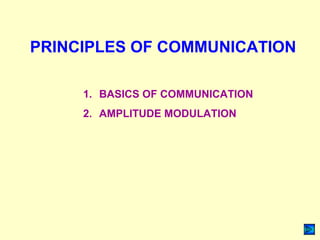
Communication - Amplitude Modulation Class 12 Part-1
- 1. PRINCIPLES OF COMMUNICATION 1. BASICS OF COMMUNICATION 2. AMPLITUDE MODULATION
- 2. BASICS OF COMMUNICATION 1. Communication: Processing, sending and receiving of information 2. Information: Intelligence, signal, data or any measurable physical quantity 3. Basic Communication System: Source of information Transmitter Link ReceiverDestination i) Speech ii) Pictures iii) Words iv) Codes v) Symbols vi) Commands vii) Data i) Oscillators ii) Amplifiers iii) Filters iv) Antenna i) Wire Links ii) Wireless iii) Optic Fibres i) Radio ii) TV iii) Computer iv) Telephone v) Teleprinter vi) Telegraph vii) Fax viii) Internet
- 3. Forms of Communication: Types of communication: 1. Radio Broadcast 2. Television Broadcast 3. Telephony 4. Telegraphy 5. Radar 6. Sonar 7. Fax (Facsimile Telegraphy) 8. E-mail 9. Teleprinting 10. Telemetering 11. Mobile Phones 12. Internet 1. Cable communication 2. Ground wave communication 3. Sky wave communication 4. Satellite communication 5. Optic fibre communication
- 4. Analogue signal A continuous signal value which at any instant lies within the range of a maximum and a minimum value. A discontinuous signal value which appears in steps in pre- determined levels rather than having the continuous change. Digital signal 0 t V 1 0 1 0 1 0 1 0 1 T/4 T/2 3T/4 T 5T/4 3T/2 7T/4 2T t 0 π 2π 3π 4ππ/2 3π/2 5π/2 7π/2 θ = ωt E ,I E0 I0 E = E0 sin ωt I = I0 sin ωt
- 5. MODULATION: Types of Modulation: 1. Amplitude Modulation 2. Frequency Modulation 3. Pulse Modulation 4. Phase Modulation Modulation is the process of variation of some characteristic of a high frequency wave (carrier wave) in accordance with the instantaneous value of a modulating signal. Modulator A.F. Signal Amp. Modulated Signal H.F. Signal Oscillator
- 6. AMPLITUDE MODULATION (AM): e m= Em sin ωmt ec = Ec sin ωct e = (Ec + Em sin ωmt) sin ωct Modulation Index (ma)= kaEm/Ec If ka=1, then ma= Em/Ec e = Ec sin ωct + (maEc/2) cos (ωc - ωm)t - (maEc/2) cos (ωc + ωm)t (Courtesy: Internet)
- 7. 1. The Amplitude Modulated wave is the summation of three sinusoidal waves with the frequencies νc, νc-νm and νc+νm namely Original frequency, Lower Side Band frequency and Upper Side Band frequency respectively. 2. The Bandwidth required for AM, BW = 2 νm 3. The amplitude Ec of the unmodulated carrier wave is made proportional to the instantaneous voltage (e m= Em sin ωmt) of the modulating wave. Voltage Amplitude νc-νm Frequency Inferences from equation for e: νc νc+νm (Courtesy: Internet)
- 8. Significance of Modulation Index: maEc= kaEm Emin Emaxe 0 Emax = Ec + maEc Emin = Ec - maEc Emax - Emin Emax + Emin ma = Generally, 0 < ma < 1 AF signal ma = 0 (No modulation) ma = 0.5 or 50% On manipulating, we get ma = 1 or 100% ma > 1 or 100% Ec
- 9. Power Relation in the AM wave: If the modulated wave is applied to a resistor of resistance R (say antenna circuit), then the r.m.s. power dissipated in the form of heat is, Pr.m.s = (1/R)[{Ec /2√2}2 + {maEc /2√2}2 + {maEc /2√2}2 ] Prms = (Ec 2 /2R) [1 + (ma 2 /2)] = Pc[1 + (ma 2 /2)] (where Pc is power dissipated by unmodulated carrier wave) If ma = 1, then Prms → Pmax and Pmax = 3 Pc /2 Similarly, Power carried by both side bands PSB = Prms / 3 which is wasted.
- 10. 1. AM is an easier method of transmitting and receiving speech signals. 2. It requires simple and inexpensive receivers. 3. It is a fairly efficient system of modulation. Drawbacks: 1. AM is more likely to suffer from noise. 2. Appreciable energy is contained by three components of AM wave. Sufficient energy can be saved by suppressing carrier wave and one of the side bands. This process makes the equipment complex. 3. Cost of such transmitters and receivers becomes practically more. Advantages: END
